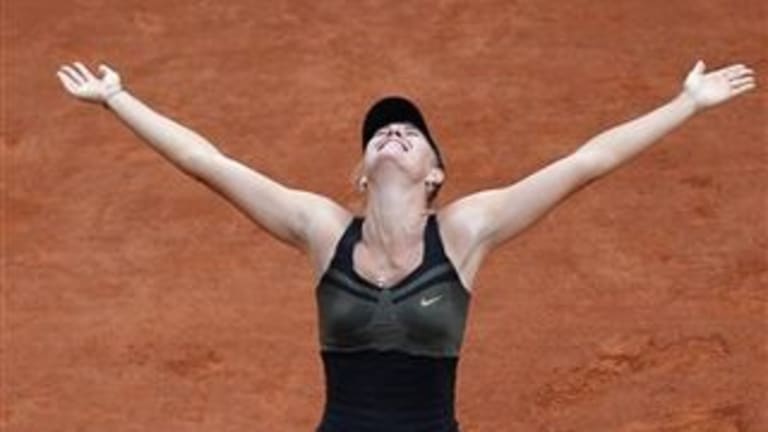History called, and Maria Sharapova answered in a voice loud and clear—emphasis on loud. Punctuating her savage groundstrokes with her familiar war cry, she belted her way into the history books with a beautifully if brutally executed win over underdog Sara Errani in the French Open final—a win that completed a coveted career Grand Slam. The scores she'll never forget were 6-3, 6-2.
Given that Errani was a lowly No. 21 seed (compared to Sharapova's No. 2), her fastest serve—95 M.P.H.—ranked her No. 100 out of 100 women (while Sharapova was right up there among the leaders), she stood 5'4" (to Sharapova's 6'2"), and this was her first Grand Slam final (while Sharapova has won three majors). . .well, it may not seem that this was a mismatch, and Sharapova's triumph pre-ordained.
Yet those lopsided comparisons don't do justice to the grit of either player, or to the way Errani made Sharapova earn nearly every point by playing as tight and error-free a final as anyone could ask. The diminutive but combative 25-year-old from Bologna made just 11 unforced errors (to 29 by Sharapova) but also hit just 12 winners compared to her opponent's 37.
The message in those stats only confirms the tone on the court: If you want this match, Errani seemed to say, you have to earn it with a demanding combination of patience and courage. This was a match full of outstanding rallies, distinguished by Sharapova's brilliant ball striking and Errani's remarkable retrieving and consistency.
It was also, in some ways, a battle between the past and present of the game, in that Errani made her way without a serve to speak of, relying on her bullet-proof groundstrokes, while Sharapova's game is built upon the platform of a vicious serve return and a first-strike sensibility. Too often, Sharapova was able to take target practice on Errani's 80 M.P.H. serves, yet she needed every one of those opportunities to keep the defensive specialist suppressed.
Errani started slowly, surrendering two breaks and winning just four points in her first four games. Clearly, she was a little tight in her first major final, while Sharapova seemed impervious to the pressure. But Errani soon got her bearings and, gifted with a pair of double faults, broke back for 1-4. Sharapova was able to make the remaining break stick, but not without some anxious moments. Errani cooly dismissed two set points while serving at 2-5, but was unable to threaten Sharapova's next service game despite the ever-lengthening rallies. Sharapova soon won the set.
Errani likes to run around her backhand to hit the shot de jour—the inside-out forehand—but that opens up the down-the-line backhand to a right-handed opponent. It's the most risky of shots, but Sharapova made good use of it today. She was also successful with her cross-court forehand, even when she hit it from well behind the baseline. Ordinarily, that's just a rally extender; so it's a tribute to Sharapova's power and precision that she was able to get so much penetration with that shot, so often.
A letdown following the loss of the first set cost Errani the first game of the second set, but she avoided going down two breaks again. The match was decided—meaning, prevented from slipping away form Sharapova—in the critical fourth and fifth games.
Serving that fourth game, Sharapova persevered and resisted any Sam Stosur-like choke—even though she had an apparent ace (at deuce) overturned by a call. The ensuing forehand error by Sharapova gave Errani a break point, but an aggressive forehand by the Russian forced a lob error. From the second deuce, Sharapova hit a forehand winner and another atomic forehand to force an error—and escape the game unharmed.
The next game was no less emblematic, even though Errani ultimately couldn't match Sharapova's hold. There were four deuces in the game, and Errani rallied her way to forehand and backhand errors by Sharapova to fend off two break points. But Sharapova broke through Errani's defenses on the third break point, when she sprinted up to make a very un-Sharapova-esque retrieve of a drop shot. She shoveled the ball back and Errani awkardly buried a volley in the net. 4-1, Sharapova. The shot was a tribute to how much Sharapova has improved her movement and balance.
True to the spirit of the match, Errani fought a guerrilla war the rest of the way, making Sharapova work hard for every point. As in the first set, Errani whittled the lead down to one break. Also as before, Sharapova was able to cling to that lead.
Serving for the match at 5-2, Sharapova reached match point but just missed with a forehand down the line. At deuce, Errani ended a rally with a delightful forehand drop shot that Sharapova was unable to reach; it was now break point. A Sharapova backhand winner returned the score to deuce. A service winner brought Sharapova to match point again—and again Errani produced a carbon copy of her last drop shot to endure.
Enough of that, Sharapova seemed to say. She blasted her sixth ace and, following yet another high-quality rally, she whacked another fierce forehand to force the error that ended it. It was a well-deserved win, as befitting the occasion on which Sharapova wrote her name large in the tennis history books.

